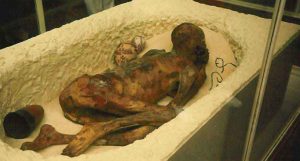Jun 30 2016
Mummies and Cancer
 Often there are several layers to my skeptical articles – there is the science story itself, and then there is the reporting of the science and the underlying neuropsychological factors that led to the disconnect between the two.
Often there are several layers to my skeptical articles – there is the science story itself, and then there is the reporting of the science and the underlying neuropsychological factors that led to the disconnect between the two.
Here we have another classic example, surrounding the claim that cancer (and sometimes extended to other “modern” diseases) were rare in pre-industrial societies based on evidence from mummies.
The Narrative
The psychological and media story here is that people tend to organize their knowledge around thematic narratives (which I am doing right here – so meta). We like stories, especially stories that have meaning, and especially when that meaning is emotionally satisfying or surprising in some way.
The media knows this, and so their business model is to cater to the narrative biases of their customers. Social media has accelerated and magnified this phenomenon as compelling narratives survive and thrive, earning likes and shares. Further, the web has been a great equalizer – outdated stories from obscure tabloids will get shared along with recent articles from established and respected outlets. Tabloids are no longer relegated to the checkout line at the grocery store.
In this case the narrative that the media has come up with is that “cancer is man-made.” This is a short and powerful narrative, a catchy headline that makes good click-bait. Further, ideological or commercial sites selling the narrative of “clean living” can exploit this simple narrative for propaganda or marketing.
The Science
As you might imagine, the science is more complex, and does not tell a simple or clean story.
Paleopathology is the study of ancient remains looking for evidence of disease, especially the cause of death. Most ancient remains are bones, and so pathological examination is limited to this tissue. However, some cultures (most famously the ancient Egyptians) practiced mummification, which preserve soft tissue, given us a potential window into ancient epidemiology.
What is uncontroversial is that ancient mummies rarely show signs of cancer. A 2010 review (the one that primarily sparked the “cancer is manmade” meme) did conclude that cancer is rare in mummies, but was much more conservative in its conclusions than the headlines:
A striking rarity of malignancies in ancient physical remains might indicate that cancer was rare in antiquity, and so poses questions about the role of carcinogenic environmental factors in modern societies. Although the rarity of cancer in antiquity remains undisputed, the first published histological diagnosis of cancer in an Egyptian mummy demonstrates that new evidence is still forthcoming.
Notice the two important caveats – the rarity of evidence for ancient cancer “might” indicate that cancer itself was rare, and the evidence itself is incomplete. Let’s tackle the second question first.
Since the publication of this review there has been more evidence. In 2011 a case of prostate cancer in an ancient mummy was published. A 2012 review of soft tissue tumors found 4 cases of malignancy and 14 cases of benign tumors. A 2014 study presents three cases of metastatic bone cancer in ancient Roman remains.
These are still not a lot of cases, but the number is growing significantly as more study is done. At present we have to conclude that the observation that ancient tumors are rare is preliminary.
Also keep in mind that negative statements, the conclusion that something is absent, are inherently problematic. They are only as good as the sensitivity of the techniques used and the thoroughness of the search. Hunting for the often subtle signs of cancer in mummified or skeletal remains is difficult and so the rarity may be partly an artifact of this difficulty.
However, even if we accept the current evidence that tumors were indeed rare in ancient populations, that does not lead directly to the conclusion that cancer is a product of modern life. As one researcher put it:
The rarity of tumors in mummies is a debated problem; short life span of past populations, scarcity of mummified remains arrived to us in comparison with skeletal remains and technical difficulties to detect neoplastic lesions in ancient tissues seem to be the main reasons of the rarity of findings. It is important to pay maximum attention to any little sign of neoplastic lesion in ancient human remains, in order to increase our limited knowledge about the type of tumours and relative incidence afflicting our ancestors.
It is possible we are just having a hard time detecting the tumors, but the short life expectancy of the ancient Egyptians is also likely a huge factor. Those who survived childhood in ancient Egypt had a life expectancy of 30 years old for women and 34 years for men, with few living past 40. Given this fact, the dearth of malignancy hardly seems like a mystery.
Conclusion
The scientific questions here are fascinating. What were disease rates in ancient populations, what evidence do we have, and how good is that evidence?
It is certainly possible that modern life does produce environmental factors that increase cancer risk. Smoking is a well established risk factor. Diets and sedentary lifestyle may also contribute.
That does not make cancer a modern or man-made disease, however. Some have oversimplified the meme even further, claiming there was no cancer before modern times. This is clearly false, as the cases referenced above indicate.
I have no reason not to at least provisionally accept the researchers’ conclusions that the relative rarity of cancer in mummies and other ancient remains is partly an artifact of the evidence, and partly due to the relatively short life expectancies of those populations.
This will not stop the “cancer is man-made” meme from continuing to crop up in social media. The narrative will live on.






